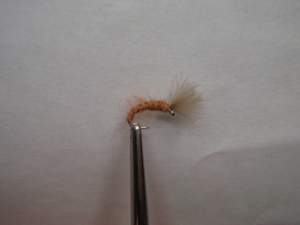MOLE FLY (BROWN)
by CHARLIE CRAVENWhen you think of the mole fly, you can’t help but remember the adage that you can’t judge a book by its cover, an inarguably simple pattern; the mole fly doesn’t sell itself or strike a sense of confidence in most onlookers. But if you were limited to one fly to cast to trout rising to baetis or midges, the mole fly would get an immediate nod. The success of the mole fly is how it sits in the water, with the hook eye parallel to the surface and the purpose-built, sodden beaver fur hanging in the film with the CDC wing perched atop. With the fly in this position it exposes it as a crippled emerger and fish know that these bugs are trapped and therefore easy prey. After catching a few fish the CDC starts losing its floatation and to help keep it afloat try using a light coating of TIEMCO DRY MAGIC (a thin gel-type floatant) that won’t mat down the delicate fibers. But dry it out first with a cloth called WONDER CLOTH DRY FLY PATCH Umpqua feather merchants markets a kit with both products called the magic patch. Most commercial fly floatants are not compatible with CDC flies.
PATTERNHOOK - #16 – 24 TIEMCO 2487
THREAD - 8/0 GRAY UNI-THREAD
BODY - BROWN BEAVER DUBBING
WING - NATURAL DUN CDCHow to Tie
- Debarb hook- mount hook in vise- start thread behind hook eye, and form a short thread base back toward the bend of the hook and stop at about where the hook point is or about ¾ down the shank of the hook.
- Select a thick CDC feather with a thin stem. Pinch the tip of the feather down into a clump and tie it to the shank just behind the eye with a couple of tight thread wraps. Hold the thread taut while you pull the end of the feather (the butt section) back to shorten the wing to about shank length long.
- Anchor the wing with a few more tight wraps of thread. With the tip of your scissors trim the feather butts at an angle.
- Wrap thread over the tapered feather butts and well into the hook bend. Bring your thread forward halfway up the shank.
- Dub a thin strand of beaver fur onto the thread, leaving a bit of bare thread between the top of the dubbing strand and the hook. Use the bare thread to work back to the end of the thread base, making the first turn of dubbing about halfway down the hook bend. Wrap forward to the base of the wing, forming a slight taper. The tapered butts of the CDC wing help build the correct body shape.
- Use tour thumb and fore finger to pull back the wing, and then bring the thread to the front of the wing just behind the hook eye. Hold the wing out of the way while you whip-finish the thread at the eye. Clip the thread.
- Use a dubbing brush to rough up the beaver fur body. By fluffing it up like this it will allow it to quickly get wet and sink the back of the fly.
Fishing Tip Cast up and across to a feeding fish and pull the fly under with a short strip – or lift of the rod tip – just before it reaches the target. The buoyant CDC pops the fly back up to the surface and it seems that any fish that witnesses this upward movement in immediately convinced, and crushes the fly.


